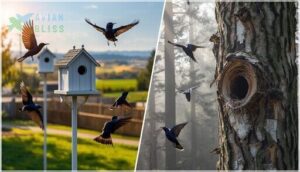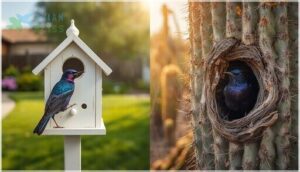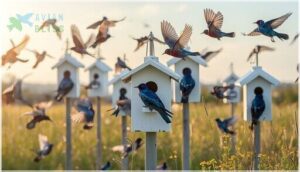This site is supported by our readers. We may earn a commission, at no cost to you, if you purchase through links.
Each spring, millions of Purple Martins complete a journey of over 5,000 miles from the Amazon Basin to backyards across North America—making them the only bird species in the eastern United States that depends almost entirely on human-provided housing.
This noteworthy relationship didn’t happen by accident. For centuries, Native Americans hung hollowed gourds to attract these glossy, blue-black swallows, recognizing their value as natural pest controllers and companions.
Today, the purple martin represents one of conservation’s most fascinating partnerships, where species survival hinges on continued human stewardship. Understanding their behavior, habitat needs, and the challenges they face reveals why your role in their story matters more than ever.
Table Of Contents
- Key Takeaways
- What is a Purple Martin?
- Purple Martin Habitat and Range
- Purple Martin Behavior and Diet
- Nesting Habits and Reproduction
- Migration and Conservation Challenges
- Frequently Asked Questions (FAQs)
- What is special about a purple martin?
- How do I attract Purple Martins to my Martin house?
- Do Purple Martins come back every year?
- Are Purple Martins aggressive?
- What is a purple martin?
- Are purple martins a problem?
- Why are purple martins so popular?
- What is a purple martin house?
- How do Purple Martins drink water?
- What is the average lifespan of a Purple Martin?
- Conclusion
Key Takeaways
- Purple Martins are the only bird species in eastern North America that depends almost entirely on human-provided housing, a relationship that began centuries ago when Native Americans hung hollowed gourds to attract these natural pest controllers.
- Eastern populations rely on artificial nest boxes with 92% occupancy rates near human activity, while western populations still use natural tree cavities but face severe habitat loss from logging and land conversion.
- Despite traveling 5,000 to 7,000 miles annually between North American breeding grounds and South American wintering sites, Purple Martin populations have declined 24% over the past 55 years, losing 2.8 million birds to invasive species competition, habitat degradation, and pesticide impacts.
- Your direct participation in providing and maintaining multi-compartment birdhouses mounted on tall poles actively shapes their survival, with over one million people currently serving as “purple martin landlords” across the continent.
What is a Purple Martin?
If you’ve ever spotted a glossy, dark bird swooping gracefully through the sky, you might’ve been watching a Purple Martin. These charismatic swallows hold a special place in North American birdlife, with a fascinating history tied to humans and a set of traits that make them unmistakable once you know what to look for.
Let’s start with the basics: their scientific classification, what they actually look like, and how to tell the males, females, and young birds apart.
Taxonomy and Classification
The Purple Martin, or Progne subis, stands as North America’s largest swallow within the family Hirundinidae. You’ll find three recognized subspecies: P. s. subis across the east, P. s. arboricola along western coasts and mountains, and P. s. hesperia in southwestern deserts.
Recent genetic diversity studies reveal significant evolutionary history between populations, sparking ongoing taxonomic debate with real conservation implications for avian species identification. In western Oregon, the species is a critical sensitive species.
Distinctive Physical Features
When you’re out in the field, learning to recognize this bird starts with noting its impressive body proportions and distinctive wing morphology. At 20.3 cm, it’s the largest swallow you’ll encounter in North America, with a wingspan reaching 39–45.7 cm.
Key identification markers include:
- Plumage iridescence creating glossy blue-purple sheens in sunlight
- Short, flat bill shape optimized for aerial insect capture
- Long, pointed wings extending beyond the tail at rest
Sexual dimorphism becomes apparent once you understand these baseline features. As excellent insect catchers, Purple Martins are a welcome sight for those looking to manage local insect populations and have a unique interaction with humans.
Differences Between Males, Females, and Juveniles
Once you’ve absorbed those structural traits, distinguishing sex and age becomes your next identification skill.
Adult males display that unmistakable glossy blue-black plumage across their entire body by their second year. Females show duller, sooty-gray foreheads and grayish underparts with variable collaring.
Juveniles resemble females closely, sporting brownish upperparts and pale, speckled bellies—making field identification trickier until their first molt completes.
Purple Martin Habitat and Range
Purple Martins don’t settle for just any spot when they breed and raise their young. Their habitat preferences vary dramatically between the eastern and western parts of North America, shaped by geography, available nest sites, and centuries of interaction with humans.
Let’s look at where these aerial acrobats make their homes and how their range spans the continent.
Breeding Habitats in Eastern and Western North America
You’ll find Purple Martins breeding in strikingly different habitats depending on where you look. Eastern populations nest almost entirely near human settlements—over 99% rely on artificial structures in farmlands, suburbs, and urban parks, often close to water. Western colonies, by contrast, use natural cavities in mature forests and riparian zones, particularly in the Pacific Northwest and isolated mountain regions.
- Eastern Nesting: Colonies of 5 to over 100 pairs thrive in open, human-modified landscapes
- Western Cavities: Decayed snags at least 30 cm wide provide essential nesting sites in forested areas
- Habitat Loss: Logging and land conversion severely limit suitable western breeding territories
- Human Impact: Eastern birds depend entirely on human stewardship, while western populations face snag removal pressures
Use of Birdhouses and Natural Cavities
Regarding nesting sites, you’ll notice Purple Martins have split into two camps. Eastern populations depend entirely on artificial nest boxes and gourds—over 1 million people provide specialized Purple Martin houses with housing occupancy rates hitting 92% near human activity.
Western birds still use natural cavities in trees and cacti, though nest site competition and natural cavity decline increasingly threaten their artificial nest success.
Geographic Distribution and Regional Variations
Across continents, Purple Martin distribution reveals striking contrasts you’ll want to understand. Eastern populations flourish where human support meets habitat requirements, while Western populations remain dependent on natural cavities, with isolated colonies facing regional threats.
Key Purple Martin distribution patterns:
- Population Hotspots concentrate in Texas, Florida, Pennsylvania, Alabama, and Louisiana
- Eastern populations depend on artificial housing east of the 102nd meridian
- Western populations rely on saguaro cacti and mountain forests
- Migration Routes span 7,000 miles to South American wintering grounds
- Range expansion occurs in California and Connecticut River Valley through conservation
Purple Martin Behavior and Diet
Purple Martins are among the most skilled aerial hunters in the bird world, spending much of their day on the wing catching insects mid-flight. Beyond their impressive hunting prowess, these social birds communicate through distinctive calls and display fascinating colony behaviors.
Here’s what you need to know about how they feed, interact, and thrive in their environment.
Aerial Insect Hunting Techniques
Purple Martins showcase exceptional aerial prowess, pursuing flying insects at speeds up to 40 miles per hour. These insectivorous birds target dragonflies, flies, and beetles in mid-air, combining rapid wing flapping with gliding maneuvers.
You’ll spot them hunting from near ground level to altitudes exceeding 900 meters during breeding season. Peak foraging follows sunrise when insect availability peaks and weather conditions improve their energy intake.
Vocalizations and Social Behaviors
Like most swallows, Purple Martins communicate through complex vocalizations that shape colony dynamics and nesting behavior. Males perform dawn songs during early spring to establish territory, while alarm calls trigger synchronized defense responses across 80% of colony residents.
You’ll observe greeting songs during pair bonding and aggressive signals when defending nest cavities—behaviors that peak during breeding season when competition intensifies.
Feeding Patterns and Diet Diversity
You’ll find that Purple Martin diet centers on aerial insect consumption, with individuals capturing approximately one prey item every 7 seconds during active foraging. Their prey diversity spans 71 species across 29 arthropod families, though mosquitoes constitute less than 3% of intake.
Foraging habitats include both high-altitude airspace and water surfaces, while seasonal diets shift based on insect emergence cycles and nutritional adaptations that support rapid nestling growth.
Nesting Habits and Reproduction
Purple Martins are colonial nesters, meaning they prefer to breed in groups rather than alone. When spring arrives, males return first to claim nest cavities and attract females through a mix of displays and vocalizations.
Understanding their nesting cycle—from courtship to fledging—reveals why these birds depend so heavily on the housing you provide.
Colony Nesting and Site Selection
For nesting, you’ll find Purple Martins thrive in colonies rather than solo. Most eastern populations now depend entirely on artificial housing—those white-painted Purple Martin houses with multiple nest boxes you’ve probably seen. Here’s what influences their site selection:
- Colony sizes usually range from 6 to 100+ nest compartments, with southeastern colonies reaching the highest densities
- Each pair claims separate nesting territories within the shared structure
- Site fidelity runs strong—about 50% of adults return annually to the same location
- They prefer open areas with no trees or buildings within 60 feet of the nest pole
- Proximity to water provides drinking access and abundant insect prey
Competition for nest boxes with invasive starlings and house sparrows remains a persistent challenge, often determining whether colonies succeed or relocate.
Courtship Displays and Mating
Once birds arrive at the colony, courtship unfolds through behavior rather than ritual. Males defend one or two nest compartments aggressively, but females ultimately choose the nest-male package.
Pairs form anywhere from 3 hours to 3 days later, bonding through shared foraging, vocal exchanges, and loafing together.
Extra-pair mating occurs frequently—young males experience paternity loss in 47% of nests, while older males face only 8%, highlighting age dynamics in breeding season success.
Egg Laying, Incubation, and Fledging
After pairing up, females begin egg laying—one per day, usually in the morning. You’ll notice clutch sizes vary from 3 to 6 eggs, with older females laying more than yearlings.
- Females lay one egg daily, usually completing clutches in under a week
- Incubation lasts 15–18 days, handled mostly by the female
- Nestlings remain in the nest for 27–36 days post-hatching
- Both parents feed young continuously during the nesting period
- Fledging occurs around 28–32 days, with 97% success at managed colonies
Reproductive success hinges on weather stability and parental experience.
Migration and Conservation Challenges
Purple Martins undertake one of the most impressive journeys in the bird world, traveling thousands of miles between their North American breeding grounds and South American wintering sites.
Unfortunately, these notable migrants face mounting challenges that have led to population declines across much of their range. Understanding their migration patterns and the threats they encounter is essential if we hope to support their survival.
Annual Migration Routes and Timelines
Each year, Purple Martins begin one of North America’s most impressive bird migration journeys, covering 5,000 to 7,000 miles between breeding and wintering grounds. These migration patterns reveal striking speed adaptations, with daily travel reaching 350 miles at sustained speeds near 25 mph.
Migration distances and timing factors vary by age and region, while stopover ecology along route variations through Central America and the Amazon basin influences seasonal occurrence of Purple Martins across continents.
Population Decline and Threats
While millions of Purple Martins still travel these extraordinary routes, you’re witnessing a species under pressure. Over the past 55 years, populations have dropped 24%, losing 2.8 million birds.
Over the past 55 years, Purple Martin populations have plummeted 24%, losing nearly 3 million birds despite their extraordinary migratory journeys
Invasive competition from starlings and house sparrows, habitat degradation, pesticide impact on insect prey, and climate effects drive this decline.
The Purple Martin population status reveals urgent conservation needs—these aerial hunters face mounting threats across their range.
Conservation Efforts and Human Support
Because Purple Martins depend almost entirely on birdhouses, your nest box management directly shapes their survival. Citizen science programs engage thousands of volunteers monitoring colonies, while technology adoption—GPS tracking and banding—guides targeted bird conservation efforts.
Public engagement through watch parties and education increases stewardship participation.
Habitat restoration projects and Purple Martin conservation partnerships expand breeding sites, reversing declines through coordinated nest boxes management and community support.
Frequently Asked Questions (FAQs)
What is special about a purple martin?
Few birds master the sky quite like this glossy aerial acrobat. You’ll witness striking purple martin behavior through remarkable insectivore diet hunting, distinctive plumage iridescence, elaborate social calls, and their unique dependency on martin housing for purple martin habitat and conservation.
How do I attract Purple Martins to my Martin house?
To attract these aerial insectivores to your birdhouses, you’ll need proper house design with 6×6-inch compartments, placement criteria requiring 40-60 feet from trees at 12-15 feet height, and predator control using pole guards for colony management success.
Do Purple Martins come back every year?
Yes, adult Purple Martins demonstrate strong site fidelity, with approximately 5% return rates annually to the same breeding colonies.
Their generational nesting patterns and migration routes reinforce seasonal occurrence at established human-provided housing locations.
Are Purple Martins aggressive?
They’re not bullies, but they’ll throw their weight around when needed. Nest site defense during breeding season is intense, especially against European Starlings and House Sparrows.
Though intraspecific tolerance generally keeps martin-to-martin conflicts minimal.
What is a purple martin?
The Purple Martin is North America’s largest swallow, measuring about 20 cm in length.
Males display glossy blue-black plumage, while females show gray underparts, making Purple Martin identification straightforward through these distinct plumage variations.
Are purple martins a problem?
Not really. Urban roosting can lead to dropping accumulation during migration, but Purple Martins don’t control mosquitoes effectively. Their main conservation balance issue involves invasive competitors like starlings outcompeting them for nesting sites.
Why are purple martins so popular?
Birdwatching communities value their pest control, consuming countless airborne insects daily. Human engagement through birdhouse adoption strengthens colony longevity, while gourds and backyard bird care create community impact, drawing over one million enthusiastic landlords.
What is a purple martin house?
Picture rows of doors opening to the sky—that’s what you’ll find in a purple martin house. These multi-compartment structures mounted on tall poles replace the natural cavities and gourds that colonies once claimed for nesting.
How do Purple Martins drink water?
You’ll see these birds swoop low over ponds and lakes, skimming the surface with their lower bill to grab water mid-flight.
Their aerial lifestyle demands this impressive surface-skimming technique for meeting hydration needs.
What is the average lifespan of a Purple Martin?
Survival Rates and Longevity Factors for these aerial acrobats average 5 to 7 years in the wild, though Banding Records document individual Purple Martins reaching 13 years despite high annual Mortality Rates affecting avian population dynamics.
Conclusion
You might think one birdhouse won’t make a difference, but the purple martin’s story proves otherwise. Each colony site you establish becomes a lifeline for birds traveling thousands of miles.
Their dependence on human housing isn’t a weakness—it’s a partnership that’s worked for centuries. By maintaining structures, monitoring arrivals, and protecting nesting sites, you’re not just observing nature. You’re actively writing the next chapter of their survival.










